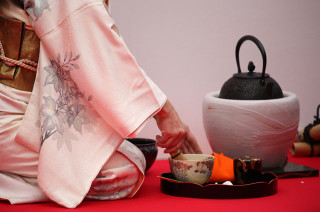Eat & Drink
Asia-Pacific
Published on May 22, 2013
In Chanoyu, A Profound Influence
By Orsolya Kako
Of all the art forms that Japan adopted from China, chanoyu, or tea ceremony, had the most profound influence, perhaps because “the way of the tea” so well suited the way of the Japanese. “Minimalism, balance and composure,” the three essentials in chanoyu, were fundamental to life.
Chanoyu: Nothing Left to Chance
In a Japanese tea ceremony, nothing is left to chance—the simple atmosphere is a result of careful calculations. The plain, straw-mat room is sparsely decorated with a seasonal scroll or flower arrangement, and tea is served in precious yet unpretentious ceramic bowls. A kimono is chosen for its design, perhaps a cherry blossom scene for spring, or autumn leaves for fall. Each design reflects simplicity and natural beauty.

In the 14th century, chanoyu was a luxurious pastime exclusively enjoyed by the aristocracy. It was not until the 17th and 18th centuries that the Japanese tea ceremony was brought to the masses, thanks to the merchant class who strove to emulate the elite. Merchant homes had a formal tea room, always four-and-a-half tatami in size, just like the 15th-century tea room used by Shogu Ashikaga Yoshimasa at his Kyoto villa, Ginkakugi the Silver Pavilion. From the room, chaniwa or tea garden, with ferns, mosses, shrubs, bamboo fences and stone lanterns are carefully tended to for guests to enjoy in quiet contemplation.
“Courtesy, politeness, modesty…”
Many of Japan’s feudal warriors were lovers of the tea ceremony. Oda Nobunaga, the ferocious mid-16th-century leader, was forced to honourably disembowel himself when he was ambushed by a treasonous general after taking a chanoyu interlude en route to war. He was avenged by another fan of the tea, Toyotomi Hideyoshi. The expansionist leader once held an elaborate 10-day tea ceremony after a successful campaign in Kyushu. His interpreter, the Portuguese Jesuit Juan Rodriguez, wrote of the Japanese tea ceremony: “Courtesy, politeness, modesty, exterior moderation, calmness, place of body, and soul without any pride or arrogance, fleeing from ostentation, pomp, external grandeur and magnificence.”
The Japanese tea ceremony uses a special green tea that is very bitter, so a sweet, pounded rice-and-bean paste is presented before the drinking. Cha kaiseki, a special type of kaiseki-ryori, evolved as part of a full-length ceremony. Today, as in feudal times, it consists of a seemingly unending course of tiny porcelain or lacquer dishes with artistically arranged vegetables, fish and rice.
The entire meal is a combination of texture, flavour, aroma and seasonal foods. Like nature, the tea ceremony provides balance.

